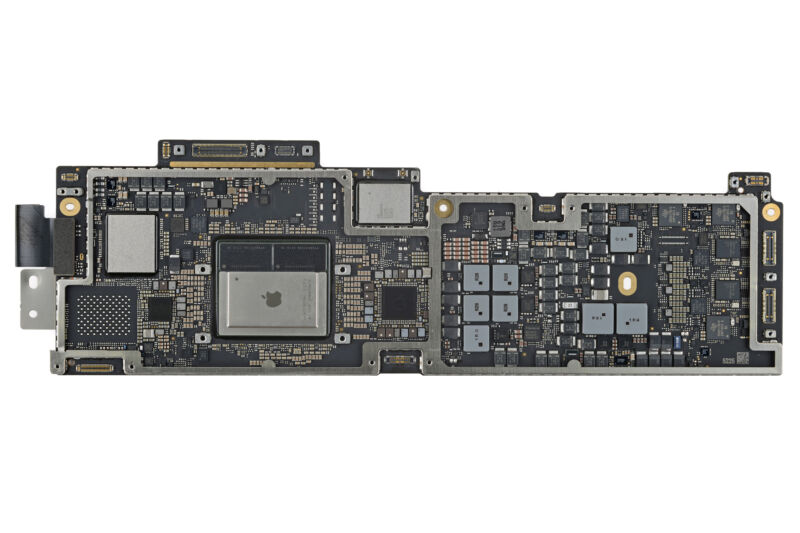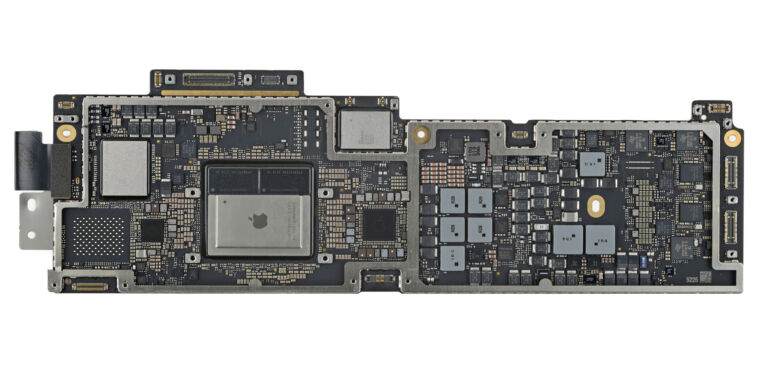
iFixit
If you read iFixit’s teardowns, in-depth reviews, or follow any tech YouTubers, you may have learned that the new M2-equipped MacBook Air is heatsink-less, in addition to being fanless.
While not something every MacBook Air owner will notice, we ran some tests, and the M2 MacBook Pro was 30 percent faster than the exact same M2 in the MacBook Air. More adventurous YouTubers have gone further—the Max Tech channel installed thin thermal pads on the MacBook Air’s M2 that significantly boosted the chip’s performance in both real-world and synthetic benchmark tests, while lower the chip’s maximum temperature from a toasty 108° Celsius to a less-toasty 97° Celsius.
Thermal pads, heatspreaders, and heatsinks all work the same way: they make close contact with the processor and conduct heat away from it. As that heat is spread over a larger surface area, it becomes easier to dissipate, making it easier to keep the processor cool. The M1 MacBook Air included a passive heatspreader (that is, one without a fan) that conducted heat away from the chip, while the M1 and M2 MacBook Pros use active cooling systems that pull in cool air and eject hot air for even more effective cooling.
The M2 MacBook Air doesn’t have a passive or active cooling system. This is common for the company’s phone and tablet chips, which don’t get as hot as the M2. But it is an odd design decision for a laptop, especially given that Apple included a heatspreader in the previous Air, and that the M2 is a larger, hotter chip than the M1 in the first place.
Before we continue, this mod isn’t something that we condone. Apart from voiding your new MacBook Air’s warranty, adding thermal pads that conduct the M2’s heat to the bottom of the laptop could cause all kinds of unintended consequences, including but not limited to “making your lap really hot.” You also risk causing accidental damage to the M2 or other components. Seriously, please do not mod your new MacBook Air just because a YouTuber did it (or at least give other people more time to discover all the unintended side effects so that you don’t have to).
That said, this is part of an unfortunate pattern for the MacBook Air—the 2020 Intel MacBook Air was also capable of better performance than it delivered, and the culprit was also the cooling system.
In a real do-as-I-say-and-not-as-I-do situation, I modded my 2020 Intel MacBook Air, so I can speak with more authority on its cooling issues. The problem there wasn’t that Apple didn’t include a heatsink and fan, but that the heatsink was set up poorly—there was too large a gap between the bottom of the heatsink and the top of the processor, and Apple had to use a larger glob of thermal paste to close that gap. But where a thin layer of thermal paste can fill in tiny gaps and improve conductivity and heat transfer, too much thermal paste leads to a much less-efficient transfer of heat. Oops! Possible fixes for the issue include using thin copper shims to close the gap between the CPU and the heatsink, as well as placing a thermal pad on top of the Air’s heatsink to improve conductivity.
Even though the causes of the thermal problems in these two MacBook Airs are different, both problems certainly feel avoidable. Maybe Apple is trying to save some money, or make the MacBook Air a tiny bit lighter. Maybe the company thinks that the performance degradation won’t actually be noticeable by most people most of the time (which is probably true). Maybe the company doesn’t think most people will use their MacBook Airs for sustained workloads that make the processor hit its thermal limits (though this would be an odd assumption to make, given the company’s renewed interest in gaming in macOS Ventura and the MacBook Air’s position as Apple’s most popular laptop).
Whatever Apple’s reasoning, letting the M2 run at higher temperatures over many years could eventually become a reliability issue—the hotter computer components run, the faster they wear out. This is also the MacBook Air design we’ll probably live with for the next three to five years, going by precedent. Apple should be cooling all of these systems properly, for the good of the hardware and the people using it.








